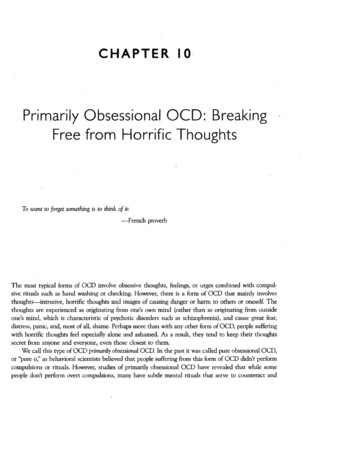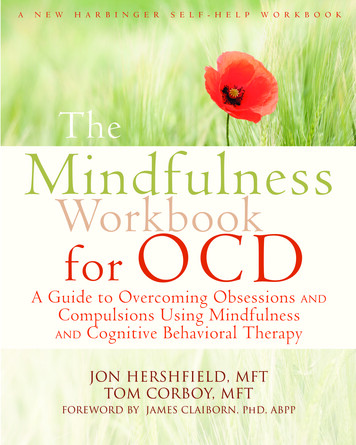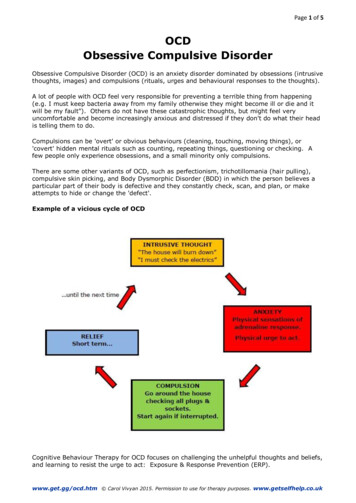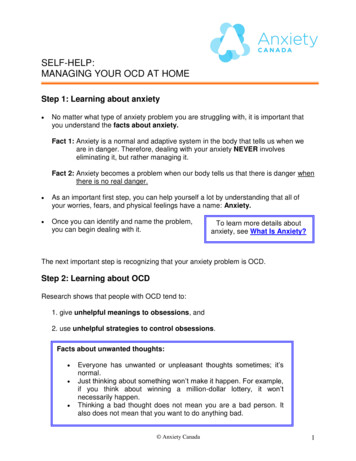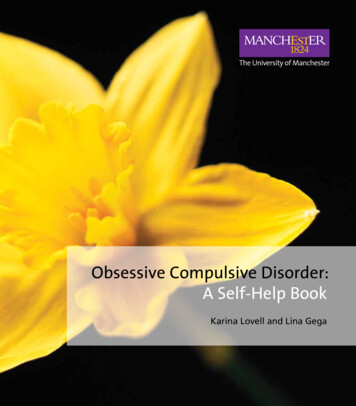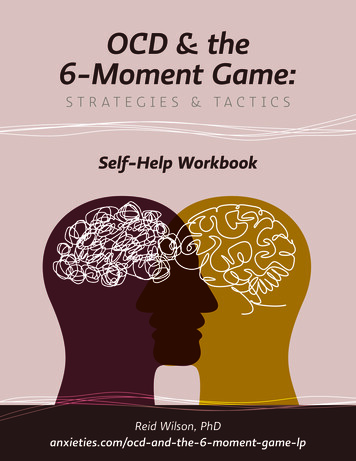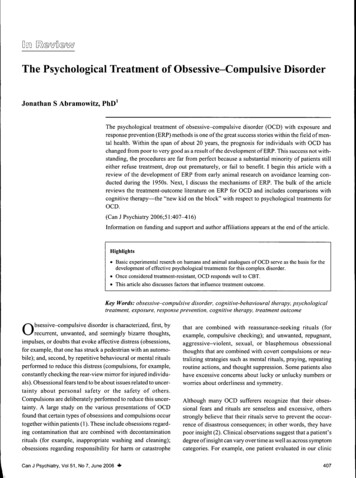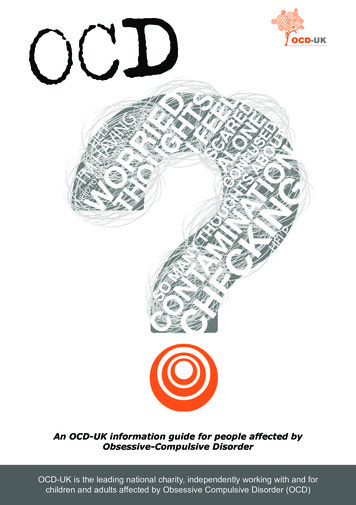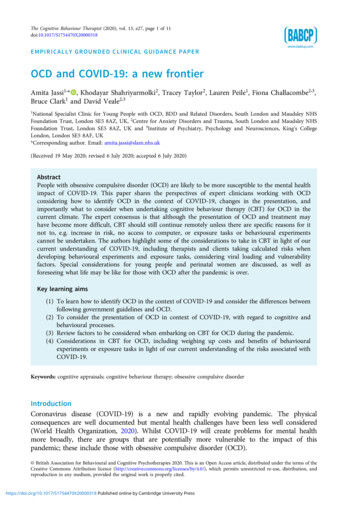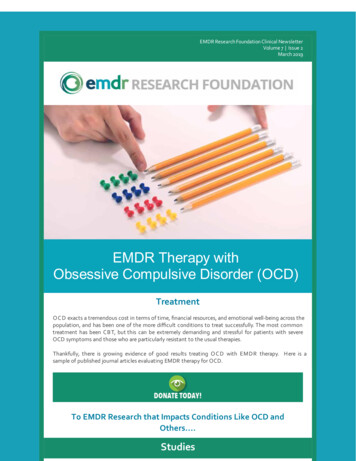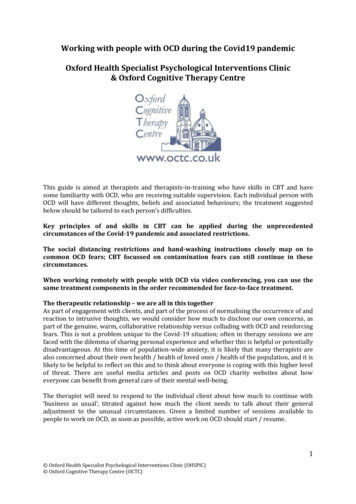
Transcription
Working with people with OCD during the Covid19 pandemicOxford Health Specialist Psychological Interventions Clinic& Oxford Cognitive Therapy CentreThis guide is aimed at therapists and therapists-in-training who have skills in CBT and havesome familiarity with OCD, who are receiving suitable supervision. Each individual person withOCD will have different thoughts, beliefs and associated behaviours; the treatment suggestedbelow should be tailored to each person’s difficulties.Key principles of and skills in CBT can be applied during the unprecedentedcircumstances of the Covid-19 pandemic and associated restrictions.The social distancing restrictions and hand-washing instructions closely map on tocommon OCD fears; CBT focussed on contamination fears can still continue in thesecircumstances.When working remotely with people with OCD via video conferencing, you can use thesame treatment components in the order recommended for face-to-face treatment.The therapeutic relationship – we are all in this togetherAs part of engagement with clients, and part of the process of normalising the occurrence of andreaction to intrusive thoughts, we would consider how much to disclose our own concerns, aspart of the genuine, warm, collaborative relationship versus colluding with OCD and reinforcingfears. This is not a problem unique to the Covid-19 situation; often in therapy sessions we arefaced with the dilemma of sharing personal experience and whether this is helpful or potentiallydisadvantageous. At this time of population-wide anxiety, it is likely that many therapists arealso concerned about their own health / health of loved ones / health of the population, and it islikely to be helpful to reflect on this and to think about everyone is coping with this higher levelof threat. There are useful media articles and posts on OCD charity websites about howeveryone can benefit from general care of their mental well-being.The therapist will need to respond to the individual client about how much to continue with‘business as usual’, titrated against how much the client needs to talk about their generaladjustment to the unusual circumstances. Given a limited number of sessions available topeople to work on OCD, as soon as possible, active work on OCD should start / resume.1 Oxford Health Specialist Psychological Interventions Clinic (OHSPIC) Oxford Cognitive Therapy Centre (OCTC)
Normalising intrusive thoughtsThis can take place as normal in face-to-face sessions, using guided discovery in exploratorydiscussion about the nature of thoughts, and relevant metaphors which help the person tounderstand how intrusive thoughts work. Lists of commonly occurring intrusive thoughts canbe found online and shared, and used to develop a discussion about the fact that there is nodifference between the intrusive thoughts experienced by the person with OCD and those whodon’t have OCD, and why the thoughts are become problematic (as they are perceived asimportant and signalling threat and responsibility). Covid-19 related cognitions could include:Thoughts: ‘That is contaminated with the virus’Doubts: ‘Did I wash my hands?’Images: Of self or others lying in hospital on a ventilatorIt is likely that most people aware of the Covid-19 virus have experienced all of these, and havebeen somewhat distressed or anxious for a short time. In OCD, it is the appraisal of thesethoughts and associated behaviours that lead to the maintenance of this distressing problem.Developing a ‘vicious flower’ formulation: identifying the threat appraisalIntrusive thoughts / doubts / images are difficult to ignore or dismiss when they are appraisedas significant, important or as signals of danger. We need to know what the occurrence orcontent of the thought means to the person experiencing it. OCD develops as a person believesthey are responsible for preventing harm, or for making restitution if they believe they havebeen responsible for harm. A number of beliefs may be relevant when developing a sharedunderstanding of how OCD is maintained:Over-importance of thoughtsTreating thoughts such as ‘this is contaminated’ or ‘I’m developing symptoms’ or images ofillness as facts and prompts to action rather than thoughts or worries that will pass.Inflated sense of responsibilityIt is important to use ‘downward arrow’ questions to ask about how the threat of Covid19 maybe related to personal responsibility to establish the key threat appraisal e.g. ‘If I don’t wash myhands properly, then I will be responsible for [transmission of Covid19 to vulnerable others?Transmission to the entire population? My own death leaving my family without a parent?]’.Questions such as ‘what is so bad about that?’ or ‘what’s the worst thing about that?’ will help toaccess beliefs about responsibility. Thought-action fusion is sometimes present within aresponsibility appraisal —when someone believes that thinking something increases thelikelihood of it actually happening and / or that having the thought is the moral equivalent ofcarrying out the thought. E.g. having a thought about a loved one dying would mean that it wasgoing to happen, and that I am wishing death on them.PerfectionismThe application of arbitrary high or impossible standards: ‘If I don’t wash my hands perfectly, Iwill contract the virus’ with a ‘perfect’ handwash concluded on the basis of a ‘just right feeling’ orby repeating a certain number of times that are unrelated to government guidelines.Intolerance of uncertaintyE.g. ‘I have to be absolutely certain that there is no trace of the virus on me’. The entire populationis having to deal with an increased level of uncertainty about the level of contagion, the length ofthe lockdown, when we can return to ‘normal’ and what society will look like at the end of thiscrisis. It is useful to discuss how this is likely to feel worse for people with OCD, but also not tomake assumptions that this is the case. What we know about uncertainty is that repeated2 Oxford Health Specialist Psychological Interventions Clinic (OHSPIC) Oxford Cognitive Therapy Centre (OCTC)
checking, reviewing and re-doing actions makes us less certain and more anxious. So repeatedmonitoring of the news, repeated hand washing, etc. are not going to make anyone feel morecertain of their safety. In fact, this may make everything more frightening.Over-estimation of threatThere is a higher level of threat in the general population that most people have everexperienced. Picking up on examples of ‘all or nothing thinking’ e.g. ‘if I touch anything I will die’and ‘jumping to conclusions’ e.g. ‘if I feel slightly unwell, I will die from the coronavirus’ can beused to unpack the idiosyncratic appraisal of risk.The anxiety equation may be helpful to establish what components maintaining the high levelsof anxiety. For example, perceiving a high probability of contagion and ‘awfulness’ of illness /death / consequences of illness / death, along with low availability of personal and nationalresources in the event of illness. This equation can be used in later sessions to help people toreflect on their perceived level of threat.Identifying maintenance factorsOnce the meaning attached to the intrusive thoughts has been identified, the next task is toestablish what someone does once that threat appraisal is activated. These safety-seekingbehaviours (SSBs), attentional biases and avoidance will all maintain the threat appraisal,perpetuating this frightening belief, and contributing to occurrence and salience of furtherintrusive thoughts. A useful phrase is ‘the solution becomes the problem’ when coming to ashared understanding of how these behaviours start off as attempts to feel better, but quicklycome maintain OCD.MaintenanceprocessHypervigilanceand selectiveattentionExamplesTo own bodilysensations e.g.being hot,coughingIncreasedawareness ofpotentialCovid19contaminants inyour own homeWhy thesolutionbecomes aproblemExamples of how totarget in CBTThe moreattention youpay to e.g. abodily sensation,the more youwill notice it,and notice lessthe occasionswhen thesensation wasabsentThe harder youare ‘looking fortrouble’, themore you willbelieve you havefound trouble,and the morefrightened youwill feelGiving examples ofhow attention isdrawn to objects (orbody parts) ofsalience‘Non-OCD’alternativeNB when this ‘nonOCD’ alternative ispossible - what elseis also possible –link to goals.Be able to disregard /tolerate changes inbodily feelingsNotice the differencebetween being veryfocused onsymptoms, vs. notBehaviouralexperiments withusing items that ‘feel’contaminatedTreat entire home asnot contaminated3 Oxford Health Specialist Psychological Interventions Clinic (OHSPIC) Oxford Cognitive Therapy Centre (OCTC)
AvoidanceWashingOf going out,people, touchingdeliveries,touching itemsin own homeElephants on thetrack metaphorTouch items in yourown home as youusually would or asothers in your homeare doingGo out - adhering tosocial distancingguidanceIgnore the doubtWashing inresponse todoubte.g. ‘are myhands reallyproperly clean?’OCD feeds ondoubt – themore you reactto a doubt, themore doubtsoccur‘Who wants to be amillionaire’ metaphorWashing hands‘perfectly’You will neverreach perfectionand trying to doso will result inever increasingfear and feelingsof guilt andresponsibilityBehaviouralexperiments of‘imperfect’ washingThe urge towash willincrease and youwill never beable to satisfyyourself that it isenoughCompletecertainty is animpossibilityBehaviouralexperiment to notwashWash your handsaccording to theGovernmentguidelinesDiscussion ofresearch on memorydistrustWash your handsaccording to theGovernmentguidelinesWashing handsafter touchingany objectImpossiblecriteriaThe more youavoid, the moreyou will want toavoidTrying to feelcompletelycertain thatyour hands arecleanWash handsaccording to theGovernmentguidelinesFollow theGovernmentguidelinesRemind yourself thatthe guidelines state20 seconds, not ‘to thepoint of perfection’You will loseconfidence inyour judgmentFirst impressions arebetter and moreaccurateTolerate or accept thefeeling of uncertainty4 Oxford Health Specialist Psychological Interventions Clinic (OHSPIC) Oxford Cognitive Therapy Centre (OCTC)
Seekingreassurancefrom othersTo try to feelcertain aboute.g. a symptom,an aspect of thetransmission ofthe virusRepeatedrequests forreassuranceincrease thefeeling of doubt,uncertainty andanxietyCheckingRepeatedchecking of theinternetRepeatedsearching forinformationincreases thefeeling of doubt,uncertainty andanxietyMental ritualsRepeatingphrases e.g. ‘I’llescape thevirus’ or‘empty’ritualisedprayingTrying to get theimage of a lovedone dying out ofyour headIncreases thefocus on thethreatThoughtsuppressionRuminationTrying to workout how ‘chains’ofcontaminationmight bespreading theCoronavirusaround yourenvironmentPreventsdisconfirmationof beliefMay lead tofurther thoughtsandreinforcement ofthe meaning oftheir occurrenceIncreases doubtLowers moodThe more youfocus on this, themore you willfind to worryaboutDiscussion of how toshare your fears withothers rather thanasking forreassurance e.g.rather than saying‘can the virus betransmitted via ?’,tell your friend/loved one that ‘I’mfeeling so anxiousabout everything andI need a bit ofcomfort / distraction/ solidarity’Behaviouralexperiments notcheckingNot needing to ask forreassuranceBehaviouralexperiments topractice not using themental ritualsAllowing thoughtsand images to comeand go without doinganythingThought suppressionexperiments e.g.white polar bearsAllowing thoughtsand images to comeand go without doinganythingDiscussion oftolerating oraccepting someuncertainty about thenature and spread ofthe virus – there areteams of scientistsaround the worldworking on this –it’snot up to you to workit outTolerating oraccepting uncertaintyand doubtAgreeing with familymembers that theywill try to provide aemotionallysupportive ratherthan informationalresponseSet specific times ofday and lengths oftime to look at theinternet and chose thesources ofinformation carefullyHow to develop a useful Theory A / Theory BTheory A / Theory B is a key therapeutic tool in CBT for OCD, health anxiety, specific phobia ofvomiting (SPOV) and other anxiety disorders.The main task in developing a theory A/B is to develop a clear, credible, and less-threateningbelief that provides an alternative belief to explore through behavioural experiments and5 Oxford Health Specialist Psychological Interventions Clinic (OHSPIC) Oxford Cognitive Therapy Centre (OCTC)
discussion. Developing theory A/B takes at least one session and is then revised and referred toin most or all of subsequent sessions.Theory A describes the threat appraisal identified in the vicious flower formulation e.g. forsomeone concerned about causing harm: ‘the problem is I am a dangerous person’. Theory B canoften take the form ‘My problem is that I worry that [I am a dangerous person]’; however, it cantake on any other form and is often a lengthier statement.For those with contamination concerns, the Covid-19 situation is likely to be feeding into theoryA, as the population is being instructed that handwashing and avoidance is the way to avoidcontracting a dangerous disease. The main message in CBT for OCD is that OCD is still not ‘yourfriend’ and what the OCD is telling the person about the level of threat and what they need to dois likely to be beyond the actual government guidelines and will be maintaining a higher level ofanxiety than is proportional to the actual risk, and will not make the person genuinely saferthan if they followed the government guidelines.When looking at the evidence section in theory A/B, watch out for getting into ‘arguments’about uncertainty e.g. we don’t know whether any one person will or will not contract the virusand what their prognosis will be. Draw on similar situations such as discussion on e.g. religion –getting into religious discussions is unhelpful – it’s very tempting to do so, but each argumenthas a counter-argument and undermines the process of developing the theory A/B. Instead, weneed to accept the uncertainty, and establish that engaging in excessive safety-seekingbehaviours (SSBs) and avoidance as part of OCD actually increases the sense of uncertainty.Similarly, employ caution with ‘arguments’ about anxiety – there is a reasonable argument thatsome level of anxiety and vigilance are necessary during the pandemic to ensure that people dostay at home and maintain distance from others, and to ensure that physical symptoms of illnessare taken seriously. However, going beyond the government guidelines fuelled by OCD relatedanxiety is not helpful, as further measures may not reduce the risk of contracting Covid-19 anyfurther, but do raise the likelihood of increasing distress and anxiety and perpetuating OCD.Theory AWhat my OCD and / or myfeelings of anxiety are saying tomeEXAMPLES OF COVID19RELATED BELIEFS:There are germs everywhereandI will get ill and dieI will infect others, who willdieThe world will end as aconsequence of Covid19[population wipe out, civildisorder, a depression of theeconomy].Theory BHow the world really works[an alternative, less threatening, credible belief]EXAMPLES OF THEORY B:There are germs everywhere, but I will be ok.Because of my OCD (my checking, avoidance ), I’ve messedwith my confidence in how the world really works, and theseSSBs make me feel anxious and alert to signs of danger,without making me actually safer.As I have previously experienced anxiety / OCD, this is a verydifficult time for me as there is a higher level of uncertaintyand threat for everyone at this moment. Understandably, likeeveryone, I am worried about Covid19, but many of thethings I’ve been doing when I am anxious have made me feelworse.In these uncertain times it is not surprising that I am‘catastrophising’. However, at many times in human historyterrible things have happened yet life has continued.6 Oxford Health Specialist Psychological Interventions Clinic (OHSPIC) Oxford Cognitive Therapy Centre (OCTC)
EXAMPLES OF EVIDENCEFOR THEORY APeople are getting infectedand dying from the virus,including ‘low risk’ people.EXAMPLES OF EVIDENCE FOR THEORY BWhen I feel anxious, I feel that it is more likely thatsomething bad will happen – the feeling of anxiety is just anunpleasant feeling, it doesn’t change the situation or thelikelihood of me contracting the virus.When I have spent a lot of time looking at the news, or havespent a long time ‘decontaminating’ myself or mypossessions, I have felt more anxious and upset although myrisk of contracting the virus has stayed the same.OCD never actually helps me – it tricks me into gaining someshort-term relief from anxiety but actually keeps me trappedin a pattern of horrible thoughts and ideas.Some people are getting infected and sadly some of them dodie; however, most people are not infected, many peoplehave mild symptoms and most people who are infected dorecover. Everyone in the world is working together to findways to stop the virus from affecting more people. There isinnovation and cooperation across the globe.EXAMPLES OF ‘WHAT I NEED TO DO’ AND FURTHER SECTIONSIf theory A is true, I need to:Watch the news reports asmuch as possible.Search the internet for storiesabout who is the most likely toget it.Focus on my body, particularlyshortness of breath, and takemy temperature frequently.Wash my hands and takeprecautions in excess of theGovernment advice.[any other safety-seekingbehaviours, avoidance orattentional bias]If theory B is true, I need to:Talk to family, friends, others about a range of day to daythings, not just the virus.Limit looking at the news to a few pre-set times a dayStop looking at stories on the internet that feed into myfears— this doesn’t keep me safer, it makes me moredistressed.Follow Government advice, not my own version of it.Acknowledge that everyone is tolerating uncertainty anddistress – this might be much harder for me, but acceptinguncertainty is better than being consumed by it.Be compassionate and kind to myself – this is a difficult andupsetting time for everyone— it’s ok to be worried, upset orsad.When I can, contribute to the efforts to support others in mycommunity or around the world— clap for the NHS, donateto a foodbank, ask a neighbour if they need help What does this say about me as a personI’m doomed.I’m in an unexpectedly difficult situation and I’m doing mybest.What does this say about the futureBleak.Everyone will be affected by this, whether or not they areinfected, and no-one knows what will happen, but it won’t goon like this forever.We are all in this together and we have an opportunity to alllearn from this experience.7 Oxford Health Specialist Psychological Interventions Clinic (OHSPIC) Oxford Cognitive Therapy Centre (OCTC)
We can use this to acknowledge that there is a real threat (i.e., Covid-19 is contagious), but wecan take a closer look at how likely it is that e.g. one will contract it, how bad it would be if onedid, and the personal, community and national resources that make more manageable if this didhappenSupporting and encouraging versus reassuranceWhen people are working hard to overcome OCD, give them support, encouragement andpraise. Their courage and strength in trying to overcome their difficulties will be impressive anduplifting. Remind them what they know about what happens to anxiety over time – it will godown. Encourage them to think about what they have done in the past to help them resist theurge to engage in SSBs and avoidance. Throughout CBT, the therapist should provide emotionalsupport and encouragement whilst modelling tolerating uncertainty and not responding toanxiety.Be aware of not providing reassurance— e.g. about actually being clean/that they are notcontaminated or will not get ill. Also discourage any extensive fact-finding mission regardingthe rates of infection or the length of time the virus lives. Remember to ask about any mentalchecking or interrogation of their own memory, or any other subtle SSBs that will underminetheir hard-fought progress.Whether to use statistics about Covid-19We can make an argument that Covid-19 is ‘no less of a threat than seasonal flu’ based on deathrates. It is important that we do not get into an exchange of statistics or opinions that are eitheran ‘over-intellectualisation’ of the problem (which takes us away from working on the emotion)or become safety-seeking behaviours (‘so it’s no less dangerous than flu so it’s ok or is it I’llcheck the population death rates again and see how they compare’). It is probably helpful toacknowledge the enormous amount of information available and to reflect on whether use ofthis information is helpful or not. If in doubt about the usefulness of information vs. itcontributing to the maintenance of OCD, devise an ‘on /off’ behavioural experiment that teststhis out e.g. look at the information vs. not - either over the course of a day as an hour on / offor as whole days on / off. The bully metaphor may be useful – asking for more and more eachtime, or that OCD pretends to be a friend – ‘I’ll protect you, I’ll keep you safe’ – watch out for the‘OCD lies’ – more OCD will make this situation harder to endure.With other contamination concerns such as HIV, TB – we know what measures we can take withthese diseases to minimise our risk of contracting them and how to minimise the transmissionrisk to others – with HIV / AIDS – safer sex, not going to unlicensed tattoo shops; TB –immunisations if you live in or are visiting a higher risk area. Covid-19 has caught us out as wedidn’t already have a population wide means of controlling the transmission and we areunaccustomed to social distancing etc. and this draws our attention back to the risk. At apopulation level, this is helpful, to control the risk. As discussed above, going beyond thegovernment guidelines fuelled by OCD related anxiety is not helpful, as further measures maynot reduce the risk of contracting Covid-19 any further, but do raise the likelihood of increasingdistress and anxiety and perpetuating OCD.8 Oxford Health Specialist Psychological Interventions Clinic (OHSPIC) Oxford Cognitive Therapy Centre (OCTC)
Planning behavioural experiments to disprove Theory A and / or build up evidence forTheory BWith some minor adjustments, therapy by remote means is similar to the face-to-face version.However, the adjustments required for behavioural experiments and exposure tasks are muchgreater. Some aspects of behavioural experiments are just the same as face-to-face sessions interm of considering how the person challenges their fears and builds up their belief in analternative, less threatening explanation. These important considerations in behaviouralexperiments for OCD conducting in vivo or remotely are:--Help the person to spot when they are trying to use their therapist for subtle or covertreassurance, to discuss it and find ways of not doing so e.g. independently devisingbehavioural experiments without telling the therapist until they have been completed.To identify and deal with covert / mental safety-seeking behaviours (e.g. selfreassurance, neutralising words / phrases / prayers, mental checking of actions) inplace of physical safety-seeking behaviours – these covert behaviours have the samefunction and will undermine the planned behavioural experiment.To help the person not avoid the worst places for triggering intrusive thoughts.To help the person realise the importance of not “storing up” compulsions, rituals orneutralising, so that they are not simply feeling super anxious UNTIL they can do theirrituals (which would undo any benefits of having confronted their fears).In face-to-face and remote working, thorough discussion of these factors should be part of thepreparation. In face-to-face work, acute observation of the person undertaking the BE oftenleads to identification of safety seeking behaviours, neutralising and/or avoidance thatundermine the BE; in remote work this will be more difficult and there will need to be greaterreliance on explicit discussion of these issues. Additionally, the service user can be asked tovideo a BE, or do it live to enable some observation.Executing behavioural experiments and generalising the findings to other situationsSome situations may be impossible to enter in the current restrictions. In place of the actualenvironment / situation, service users can use imaginal exposure, or use e.g. video footage totrigger the OCD. However, for non-Covid-19 related fears, with appropriate preparation, theperson can confront their fears, and modelling can take place. Online versions of behaviouralexperiences could include, for example, for religious concerns, undertaking a remote tour of areligious building to provoke unwanted blasphemous thoughts; for concerns regardingattraction to children, watching a children’s film. Unlike face-to-face behavioural experiments,this will sometimes mean planning in the previous session so that the appropriate materials areeasily to hand both for therapist and service user. In the early stages, modelling by the therapistcan be included in the sessions. This may require both therapist and service user to have thesame “props” with them.As with face-to-face in vivo work, sessions are predictable and respectful, with permission beingsought from the person you are working with for any fear confronting activity. This includesactivity by the therapist. As with face-to-face work, watch out for any “tracking”; that is,anything the person with OCD is doing so that they can later “undo” things that they haveconfronted. It is important to not proceed with the behavioural experiment if “tracking” isplanned; instead, collaboratively re-think the behavioural experiment as a task that the personcan approach and attempt without safety-seeking behaviours before or after.Sessions should, as with face-to-face, be long enough to complete the planned exposure andleave the person with reduced levels of anxiety (relative to the peak). Interrupting sessionswhilst maintaining the activity confronting fears is also reasonable i.e. starting a long9 Oxford Health Specialist Psychological Interventions Clinic (OHSPIC) Oxford Cognitive Therapy Centre (OCTC)
behavioural experiment in the morning, then resuming contact later in the day to find out whathappened.Continuation of work alone including relapse prevention / managementEncourage the person you are working with to:- Always look for opportunities to challenge the OCD- Never do anything you are intending to undo- If you are overwhelmed and undo things, then wait a while and redo it- Remember that the point of all this hard work is to live a life free from OCDRelapse prevention / management plans or ‘blueprints’ should include detailed thoughts on:- What signs of trouble do I need to look out for when the restrictions are lifted? What canI do in these circumstances?- What can I do if there is another set of restrictions or another pandemic?10 Oxford Health Specialist Psychological Interventions Clinic (OHSPIC) Oxford Cognitive Therapy Centre (OCTC)
Working with people with OCD during the Covid19 pandemic Oxford Health Specialist Psychological Interventions Clinic & Oxford Cognitive Therapy Centre This guide is aimed at therapists and therapists-in-training who have skills in CBT and have some familiarity with OCD, who are receiving suitable supervision. Each individual person with
